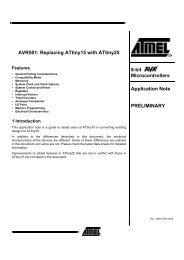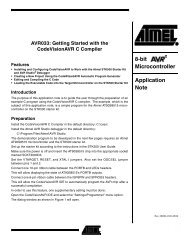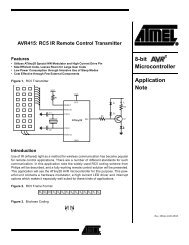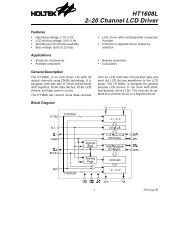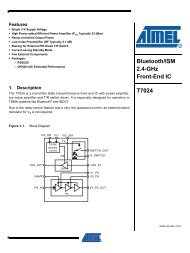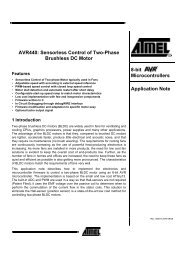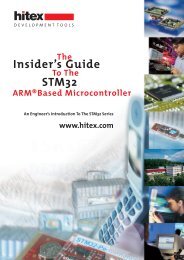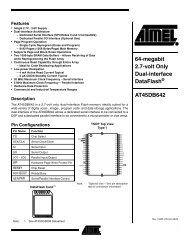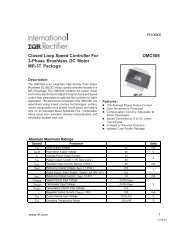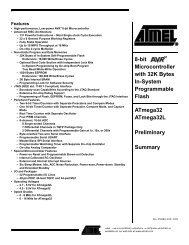Preliminary C8051F120/1/2/3 C8051F124/5/6/7 - KEMT FEI TUKE
Preliminary C8051F120/1/2/3 C8051F124/5/6/7 - KEMT FEI TUKE
Preliminary C8051F120/1/2/3 C8051F124/5/6/7 - KEMT FEI TUKE
Create successful ePaper yourself
Turn your PDF publications into a flip-book with our unique Google optimized e-Paper software.
<strong>Preliminary</strong><br />
<strong>C8051F120</strong>/1/2/3<br />
<strong>C8051F124</strong>/5/6/7<br />
23.2. Timer 2, Timer 3, and Timer 4<br />
Timers 2, 3, and 4 are 16-bit counter/timers, each formed by two 8-bit SFR’s: TMRnL (low byte) and TMRnH (high<br />
byte) where n = 2, 3, and 4 for timers 2, 3, and 4 respectively. Timers 2 and 4 feature auto-reload, capture, and toggle<br />
output modes with the ability to count up or down. Timer 3 features auto-reload and capture modes, with the ability to<br />
count up or down. Capture Mode and Auto-reload mode are selected using bits in the Timer 2, 3, and 4 Control registers<br />
(TMRnCN). Toggle output mode is selected using the Timer 2 or 4 Configuration registers (TMRnCF). These<br />
timers may also be used to generate a square-wave at an external pin. As with Timers 0 and 1, Timers 2, 3, and 4 can<br />
use either the system clock (divided by one, two, or twelve), external clock (divided by eight) or transitions on an<br />
external input pin as its clock source. The Counter/Timer Select bit C/Tn bit (TMRnCN.1) configures the peripheral<br />
as a counter or timer. Clearing C/Tn configures the Timer to be in a timer mode (i.e., the system clock or transitions<br />
on an external pin as the input for the timer). When C/Tn is set to 1, the timer is configured as a counter (i.e., high-tolow<br />
transitions at the Tn input pin increment (or decrement) the counter/timer register. Timer 3 and Timer 2 share the<br />
T2 input pin. Refer to Section “18.1. Ports 0 through 3 and the Priority Crossbar Decoder” on page 205 for<br />
information on selecting and configuring external I/O pins for digital peripherals, such as the Tn pin. Timer 2 and 3<br />
can be used to start an ADC Data Conversion and Timers 2, 3, and 4 can schedule DAC outputs. Only Timer 1 can be<br />
used to generate baud rates for UART 1, and Timers 1, 2, 3, or 4 may be used to generate baud rates for UART 0.<br />
Timer 2, 3, and 4 can use either SYSCLK, SYSCLK divided by 2, SYSCLK divided by 12, an external clock divided<br />
by 8, or high-to-low transitions on the Tn input pin as its clock source when operating in Counter/Timer with Capture<br />
mode. Clearing the C/Tn bit (TnCON.1) selects the system clock/external clock as the input for the timer. The Timer<br />
Clock Select bits TnM0 and TnM1 in TMRnCF can be used to select the system clock undivided, system clock<br />
divided by two, system clock divided by 12, or an external clock provided at the XTAL1/XTAL2 pins divided by 8<br />
(see Figure 23.14). When C/Tn is set to logic 1, a high-to-low transition at the Tn input pin increments the counter/<br />
timer register (i.e., configured as a counter).<br />
23.2.1. Configuring Timer 2, 3, and 4 to Count Down<br />
Timers 2, 3, and 4 have the ability to count down. When the timer’s Decrement Enable Bit (DCEN) in the Timer Configuration<br />
Register (See Figure 23.14) is set to ‘1’, the timer can then count up or down. When DCEN = 1, the direction<br />
of the timer’s count is controlled by the TnEX pin’s logic level (Timer 3 shares the T2EX pin with Timer 2).<br />
When TnEX = 1, the counter/timer will count up; when TnEX = 0, the counter/timer will count down. To use this feature,<br />
TnEX must be enabled in the digital crossbar and configured as a digital input.<br />
Note: When DCEN = 1, other functions of the TnEX input (i.e., capture and auto-reload) are not available.<br />
TnEX will only control the direction of the timer when DCEN= 1.<br />
© 2002 Cygnal Integrated Products, Inc. DS008-0.8-AUG02 Page 283



